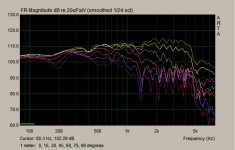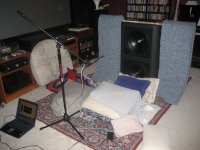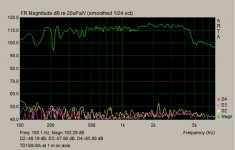Hey Lynn,
Thought this might interest you: Plasma tweeter
vetruvioaudio.com

Anyway, this thread is a goldmine! Great thoughts, great posts!
Thought this might interest you: Plasma tweeter
vetruvioaudio.com
Anyway, this thread is a goldmine! Great thoughts, great posts!
Hi,
No, it is like you say. Less reflections => more detail.
Because of the usually high directivity of these speakers.
- Elias
Elias, does sound reproduction with less reflection lead to perceiving less detail? I thought the research showed that the other way around--at least as far as intelligibility is concerned.
No, it is like you say. Less reflections => more detail.
Except that they're still intelligible in the horns at extremely low level.
I agree with Badman. Intelligibility of song lyrics is a pretty simple criteria: either they're easy to understand or not. Some speakers do well at low levels, and others do not.
Electrostats and horns do well at intelligibility at low levels, and other types vary.
Because of the usually high directivity of these speakers.
- Elias
Because of the usually high directivity of these speakers.
Hello Elias
Not all horns have high directivity. I wouldn't call a 100x100 patern high directivity. Even then they still have excellent dialog intelligibility. It helps but I think there is more involved than just directivity. It just might be the horns couple to the air better than some cones and you get more detail. Look at the horn mouth area compared to say a 1" dome. Same with electrostatic panels.
Rob
Hey Lynn,
Thought this might interest you: Plasma tweeter
vetruvioaudio.com
Anyway, this thread is a goldmine! Great thoughts, great posts!
Nothing for kids an pets - and not taking care about O3 pollution as far as I can see...
Nice looking though - sort of "cookers for the tent" style.
Michael
Who would have thought that Alnico magnets, tube amplifiers, and paper cones with pleated surrounds would ever become "exotic"? All those came standard with every TV, radio, and hifi system back in the Fifties.Mr Olson,
Luckily, there are still some driver manufacturer (Accueil)
that still use these principles and the next generation is continuing the work.
They were low qts, high efficient drivers that enable the use of low power tube amp that
had high output impedance , no negative feedback. Combine this with full range
no crossover and the principle of less is more kicks in.
Luckily, there are still some driver manufacturer (Accueil)
that still use these principles and the next generation is continuing the work.
They were low qts, high efficient drivers that enable the use of low power tube amp that
had high output impedance , no negative feedback. Combine this with full range
no crossover and the principle of less is more kicks in.
I still think the Proton 25" that I has was really hard to beat. Even though the resolution nowadays is higher, color really leaves a lot to be desired.How long before CRT TV's become "exotic"?
I still think the Proton 25" that I has was really hard to beat. Even though the resolution nowadays is higher, color really leaves a lot to be desired.
Go and try plasma - not in a shop preferably...
Michael
A Tivoli does speech OK too.
Shift its boxed speaker to OB and I'd be surprised if its not even more close to golden vintage sound
Last edited:
Why did you hang the insulation on either side of the speaker? Are you going to use those in the final design or where you trying to remove the effects of the baffle on the speaker's response? However you put them behind the round over on the baffle, so I don't quite see the point...?
It's not part of the design; I was just trying to minimize the impact of other stuff in the room, especially in the area behind the speakers. After taking the 90 degree measurement, I did an overlay and repeated it without the insulation. It only made a minor difference -- some of the nulls in the LF area weren't as deep.
Gary Dahl
Gary Dahl
I'm no expert when it comes to using ARTA.
Me neither
One or two remarks if you allow
If your mic is not calibrated in SPL you better state that explicitely as otherwies people would think your were measuring at the 110dB SPL shown - which most likely was not the case ??
Regarding distortion measurement - same as above (you know, distortion varies heavily with SPL).
Also distortion seems to be veeeery low, so might be something else went wrong ??
Can't figure out at the moment....
Whats the gating time for the polar plots? - from the roughly 100 Hz indecator it seems you have included a lot of room response - so you might cut shorter - roughly 3ms at best I'd guess for the setup shown. (you can check in the impulse response where first reflections arrive and slide window accordingly)
For low frequencies (below the indicator) you possibly want to make a close mic measurement too (if that department is of special interest for you)...
Michael
Last edited:
Hi Michael,
Thanks for your remarks. I was most definitely not measuring at 110 dB! My mic preamp gain is set up for proper calibration with the software, but the gain of the power amplifier isn't accounted for in the ARTA settings. This was the first time I had used the distortion measurement option, so I don't doubt there is more to learn about it.
The gating times were indeed long, but I don't have the figures anymore. The reflection wasn't clear, which is why I tried the insulation next to the speakers. In any event, I had to put everything away to prepare for my daughter's horn lesson this afternoon, but look forward to setting it up again and trying some more measurements.
Gary Dahl
Thanks for your remarks. I was most definitely not measuring at 110 dB! My mic preamp gain is set up for proper calibration with the software, but the gain of the power amplifier isn't accounted for in the ARTA settings. This was the first time I had used the distortion measurement option, so I don't doubt there is more to learn about it.
The gating times were indeed long, but I don't have the figures anymore. The reflection wasn't clear, which is why I tried the insulation next to the speakers. In any event, I had to put everything away to prepare for my daughter's horn lesson this afternoon, but look forward to setting it up again and trying some more measurements.
Gary Dahl
Wow, that is pretty nice. Off axis looks amazing.
One little tidbit - if I were going to do these off axis measurements, I would do them outdoors, about 10 feet off the ground, at either 1 or 2 meters - I've found that works well for mid to low frequency measurements, in terms of avoiding reflections. Gate in the area of 15 to 40 ms. I like to do them with a 2.83Vrms terminal voltage. Any idea what the sensitivity of these are?
Although I already have plenty other projects to work on, this project has me very interested!
One little tidbit - if I were going to do these off axis measurements, I would do them outdoors, about 10 feet off the ground, at either 1 or 2 meters - I've found that works well for mid to low frequency measurements, in terms of avoiding reflections. Gate in the area of 15 to 40 ms. I like to do them with a 2.83Vrms terminal voltage. Any idea what the sensitivity of these are?
Although I already have plenty other projects to work on, this project has me very interested!
Last edited:
I would do them outdoors, about 10 feet off the ground, at either 1 or 2 meters
Oof! Someone else can hoist 'em up there!
Yes, that would certainly yield cleaner measurements...
Lynn and Michael have given some suggestions (online and off), which I will put to use when I set up the next ARTA session.
Gary Dahl
Thanks Gary! Looks like a 1k max upper limit, but lower would be better. Off axis response os so telling. The first graph looked smoother on axis. Maybe I better go have another look. You could probably get that cone to settle a bit further through damping and make the crossover easier if you are crossing over high.
Oh, I personally like a 5dB scale for a bit more detail when I do graphs.
Thanks again,
Dan
Oh, I personally like a 5dB scale for a bit more detail when I do graphs.
Thanks again,
Dan
Last edited:
The first graph looked smoother on axis.
Yeah, I thought so too. Lynn says it's all contaminated by the long window and early reflections that ought to be minimized, so we can't tell much from the graph. I'll work on the setup some more and see if I can get things cleaned up.
You could probably get that cone to settle a bit further through damping and make the crossover easier if you are crossing over high.
No plans to cross over high, but I do want things to be as well-behaved as possible for a good distance beyond the band I'm using.
Gary Dahl
Last edited:
Trade off, as always.
TD15M has coating on its cone already. Further damping might probably add too much mass and affect other performances (in negative ways).
And that measurement is already excellent for its size, isn't it? Or, TBH, I've never seen any better 15"er in this regard.
TD15M has coating on its cone already. Further damping might probably add too much mass and affect other performances (in negative ways).
And that measurement is already excellent for its size, isn't it? Or, TBH, I've never seen any better 15"er in this regard.
- Home
- Loudspeakers
- Multi-Way
- Beyond the Ariel


